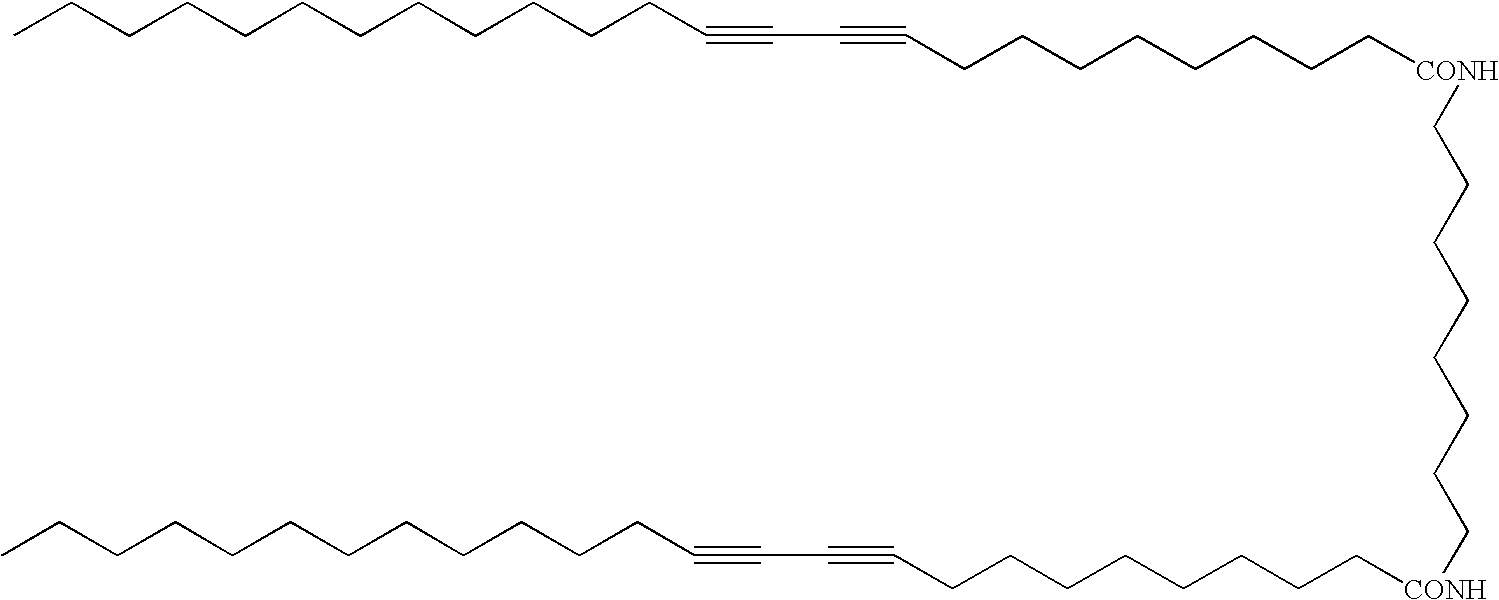Thermoplastic material comprising polychromic substances
a polychromic substance and thermoplastic material technology, applied in the field of thermoplastic materials, can solve the problems of poor compatibility of diacetylene compounds with, and inability to blend into, polyolefins, and easy degradation of diacetylene compounds at processing temperatures
- Summary
- Abstract
- Description
- Claims
- Application Information
AI Technical Summary
Problems solved by technology
Method used
Image
Examples
reference example 1
Mono-Amide Diacetylene Compound 1
[0038]10,12-Pentacosadiynoic acid (ex. GFS Chemicals, 8.0 g) was dissolved in dichloromethane (150 ml) under a nitrogen atmosphere. To this solution oxalyl chloride (ex. Aldrich, 6.0 g) was added followed by the addition of 10 drops of DMF. The reaction mixture was then stirred at 20° C. for 4 hours.
[0039]Propargylamine (ex. GFS Chemicals, 1.27 g) dissolved in 10% aqueous sodium hydroxide solution (50 g) was added to the 10,12-pentacosadiynoic acid chloride reaction mixture over 10 minutes. The reaction mixture was then left stirring for 30 minutes at 20° C. The reaction mixture was then left to phase separate overnight. The lower DCM phase was then removed and placed in a freezer overnight. The result precipitate was collected using vacuum filtration and dried in an oven at 40° C.
reference example 2
Bis-Amide Diacetylene Compound 2
[0040]10,12-Pentacosadiynoic acid (ex. GFS Chemicals, 8.0 g) was dissolved in dichloromethane (150 ml) under a nitrogen atmosphere. To this solution oxalyl chloride (ex. Aldrich, 6.0 g) was added followed by the addition of 10 drops of DMF. The reaction mixture was then stirred at 20° C. for 4 hours.
[0041]1,8-Diaminooctane (ex. GFS Chemicals, 1.58 g) dissolved in 10% aqueous sodium hydroxide solution (50 g) was added to the 10,12-pentacosadiynoic acid chloride reaction mixture over 10 minutes. The reaction mixture was then left stirring for 30 minutes at 20° C. The resultant precipitate was collected by vacuum filtration and dried in an oven at 40° C.
example 3
Application of Compound 1 to a Substrate Using a Surface Coating Technique
[0042]An ink was formulated comprising:
(i)Compound 1 5 g(ii)A 15% solution of Elvacite 202895 g.(ex. Lucite International, a low molecularweight methacrylate copolymer) in MEK
[0043]The ink formulation was milled for 10 minutes using a 50 ml Eiger-Torrance bead mill.
[0044]The ink was drawn down on to photocopy paper and HiFi 50 micron white PET film to give a coatweight of approximately 3 to 6 gsm.
[0045]Both coated substrates were initially white and turn blue on exposure to broadband ultraviolet radiation supplied by a Jenten UV curing machine. Further exposure of the coated substrate to infrared radiation using a Bosch heat gun resulted in the blue changing to a magenta, then red, then orange and then a yellow colour.
[0046]A 266 nm, 3 W UV laser linked to an IBM compatible PC was used to write text and draw artwork and devices on the coated substrate. These images could be produced in one colour or multi-colo...
PUM
| Property | Measurement | Unit |
|---|---|---|
| Temperature | aaaaa | aaaaa |
| Temperature | aaaaa | aaaaa |
| Fraction | aaaaa | aaaaa |
Abstract
Description
Claims
Application Information
 Login to View More
Login to View More - R&D
- Intellectual Property
- Life Sciences
- Materials
- Tech Scout
- Unparalleled Data Quality
- Higher Quality Content
- 60% Fewer Hallucinations
Browse by: Latest US Patents, China's latest patents, Technical Efficacy Thesaurus, Application Domain, Technology Topic, Popular Technical Reports.
© 2025 PatSnap. All rights reserved.Legal|Privacy policy|Modern Slavery Act Transparency Statement|Sitemap|About US| Contact US: help@patsnap.com



